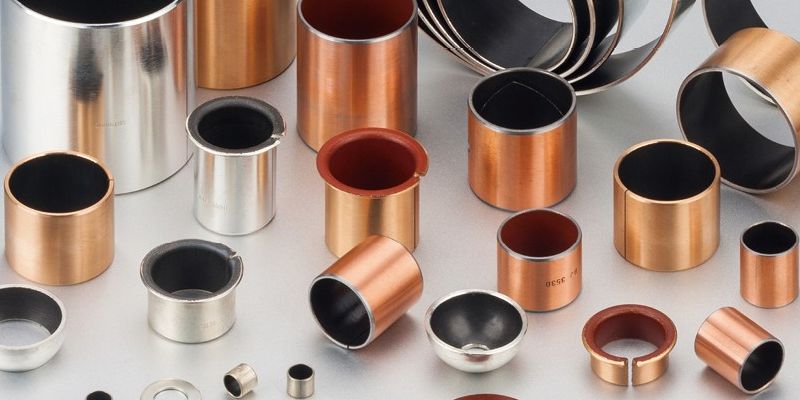The age-old adage “time is money” has never been more true than in the industrial world. In order to keep production lines running smoothly and efficiently, it’s essential that all components are functioning properly and at peak capacity. One such component is the sleeve bearing – a critical piece of equipment used in many machines and motors. It’s important to understand how this engineering marvel works if you’re dealing with any type of industrial machinery.
A sleeve bearing is essentially a cylinder containing two layers of metal separated by a lubricant or ball bearings. This combination allows for an incredibly smooth operation, as well as providing extra protection from wear and tear over time. Turklāt, its ability to handle both radial and axial loads makes them highly versatile in their usage across various industries. As these bearings need little maintenance, they can be relied upon for years without issue.
Sleeve bearings have become increasingly popular due to their reliability and cost effectiveness when compared to other types of bearings on the market today. With proper care and attention paid towards installation, operational performance should remain high throughout the life of the product; ensuring maximum productivity while avoiding costly repairs or replacements down the line. Understanding sleeve bearing technology is key for anyone looking to maximize efficiency within their facility or machine shop!

What Is A Sleeve Bearing
A sleeve bearing is a type of journal bearing that uses thin metal sleeves to provide low friction between the moving parts. These bearings are also known as sleeve bushings and can be made from materials such as bronze, copper, or acetal. They are commonly found in applications where high speeds and accuracy are important, such as automobiles and robotics. Sleeve bearings help minimize wear on the shafts they support while providing an effective seal against dirt and moisture.
Sleeve bearings come in various shapes and sizes depending on their application. The most common types are flanged sleeve bearings, which feature two axially aligned disks with a hole for the shaft to pass through; this design helps reduce vibration and improve load-bearing capacity. Other varieties include radial sleeve bearings which have one disk with holes for radial loads, thrust sleeve bearings which use multiple disks for heavy thrust loads, and spherical sleeve bearings which contain curved surfaces for smoother motion.
No matter the type or size of bearing used, all offer advantages over the traditional ball or roller bearings due to their minimal contact area and low coefficient of friction. This makes them ideal for applications where speed, precision, and durability are paramount. With these benefits in mind, it’s easy to see why sleeve bearings have become so popular across many industries today.
Types Of Sleeve Bearings
There are different types of sleeve bearings, each with its own unique assembly. The most common type is the cylindrical bearing, which consists of a steel casing that houses two circular pieces of metal separated by a lubricant or grease to reduce friction and wear. Another popular option is a tapered bearing, which has an angled inner surface that helps provide more stability during operation. Turklāt, there are split-sleeve bearings that can be used when access to the inner parts of the shaft is limited.
Sleeve bearings differ from ball bearings in several ways. Ball bearings rely on rolling elements between outer and inner rings instead of simply sliding against one another as with sleeves. As such, they often require higher precision for installation but can also support heavier loads over time than their counterparts. Papildus, ball bearings tend to generate less noise and vibration than sleeve bearings since contact is made only at discrete points rather than along a larger area like with a sleeve system.
Lastly, sleeve bearings have fewer components than ball bearing systems, making them easier to install and maintain while still providing reliable performance under typical operating conditions. This makes them especially useful in situations where space is limited or extra rigidity or durability isn’t required. With these considerations in mind, it’s easy to see why many businesses choose sleeve bearings for their applications. Moving forward, we’ll take a closer look at the advantages of using this type of bearing system in various scenarios.
Advantages Of Sleeve Bearings
Sleeve bearings are an ideal choice for many applications due to their simplicity and durability. They provide rotational performance support by providing a low friction surface between the shaft and the bearing, which allows for reduced energy consumption in operation. Sleeve bearings also have a small footprint, making them suitable for applications where space is limited. Turklāt, they can be easily assembled or disassembled without much effort due to their simple design.
Shaft sleeve bearings offer superior protection against wear and tear caused by dust particles, dirt and other contaminants as well as high temperatures. Metāla polimēru bukse, these units require little maintenance since they do not need lubrication like most other types of bearings. Rezultātā, they are cost-effective solutions that improve operational efficiency while reducing operating costs. Turklāt, they can be used in both dry and wet conditions with no modifications necessary.
The dependability of sleeve bearings makes them attractive choices for industrial machinery requiring reliable motion control components; therefore, it is no wonder why so many companies rely on this type of bearing when designing equipment. All in all, shaft sleeve bearings are versatile components that deliver smooth operations at lower costs than alternatives such as a ball or roller bearings. With that said, it’s clear why they continue to remain popular within the industry. Moving forward then…
Disadvantages Of Sleeve Bearings
Sleeve bearings are not suitable for high speeds, as studies have shown that their maximum speed is around 5,000 RPM. This limitation can cause problems in applications requiring higher rotational speeds such as electric motors and fans. Another disadvantage of sleeve bearings is the fact that they require more maintenance than other types of bearings due to lubrication requirements. If a sleeve bearing isn’t properly lubricated on a regular basis, it will wear out much faster compared to its counterparts. Metāla polimēru bukse, these types of bearings produce frictional heat which must be dissipated or else the temperature may become too high and lead to failure.
Another issue with using sleeve bearings is that they tend to have limited life expectancy when used in heavy-duty applications like large industrial machines. Their design also makes them unsuitable for radial loads since they can deform easily under pressure. Lastly, if there’s an increase in dirt particles from the environment getting into a sleeve bearing, this could potentially cause premature failure over time.
Given the various drawbacks associated with sleeve bearings, engineers must carefully consider whether this type of bearing is appropriate for their application before making any final decisions about material selection.
Materials Used In Sleeve Bearings
Sleeve bearings are widely used in industrial applications due to their low cost and ease of installation. They come in a variety of materials, depending on the application for which they are being used. The most common materials used are:
- Metāli:
- Steel
- Aluminum
- Šīs bukses nodrošina izcilu noguruma izturību un nestspēju
- Non-metallic Materials:
- Plastic & Polymers
- Ceramics
- PTFE
Each material has its own unique advantages and disadvantages that should be taken into consideration before selecting sleeve bearing materials. For example, steel is strong and durable but more expensive than other options; aluminum is lightweight but may not withstand extreme temperatures; plastic/polymer offers high corrosion resistance but can wear quickly when exposed to abrasion or vibration; and ceramics provide excellent heat transfer capabilities but require special lubricants. Ultimately, it’s important to choose a material that best meets your needs while also taking into account any budgetary constraints you may have.
With this information in mind, let’s explore some of the applications where sleeve bearings offer an ideal solution.
Applications Of Sleeve Bearings
Sleeve bearings are used in a variety of applications, from those found in household appliances to industrial machinery. These bearings provide low-friction motion and have been used for centuries due to their simplicity and long service life.
In the home, sleeve bearings can be found in fans, blenders, dishwashers, water pumps and other small appliances. In larger machines like washing machines or clothes dryers, sleeve bearing assemblies may also be present. Sleeve bearings are typically made of brass, bronze or aluminum and equipped with oil ports for lubrication. This helps reduce friction between the shafts of these devices and increases their performance over time.
Industrial applications include conveyor systems, agricultural equipment, hydraulic cylinders and printing presses among others. Because they offer relatively good load capacity while being easy to install and maintain, they are frequently chosen by engineers when designing new mechanisms and systems. Sleeve bearings are often more cost effective than other types of bearing options as well.
Contact our sales team today to discuss which is the best sleeve bearing for your applications,
